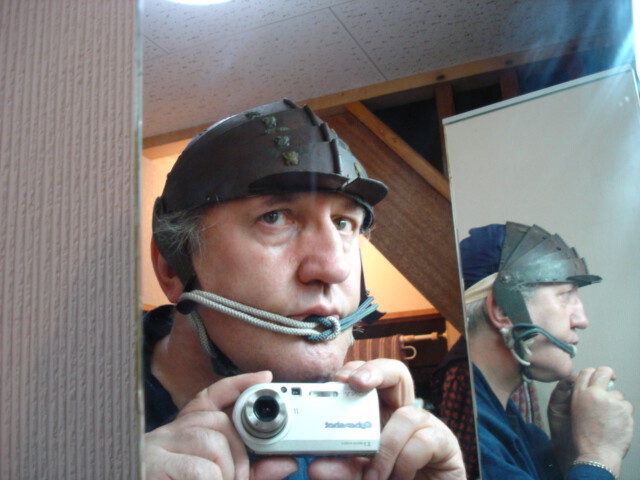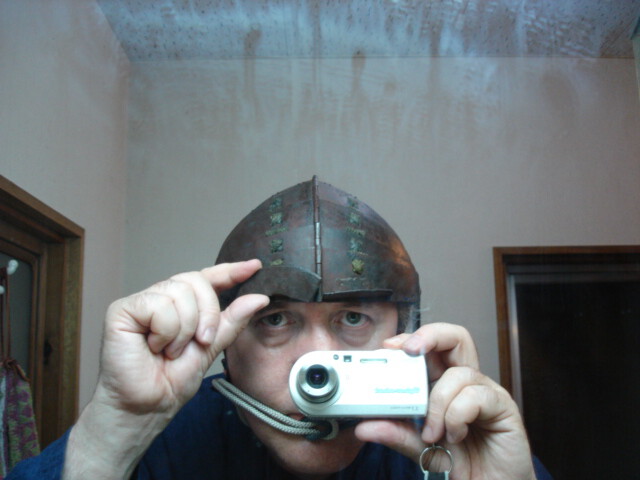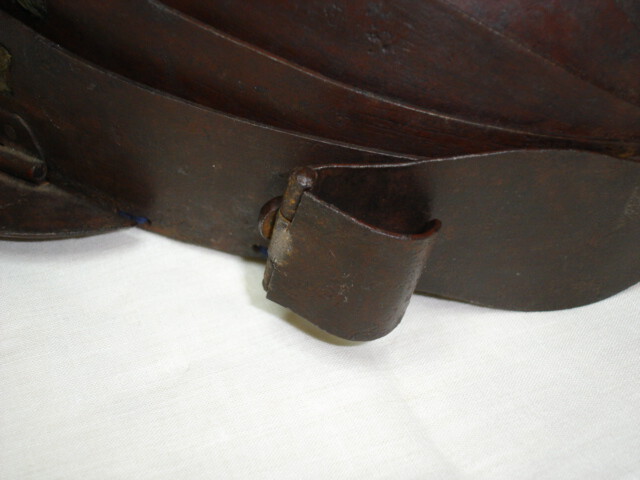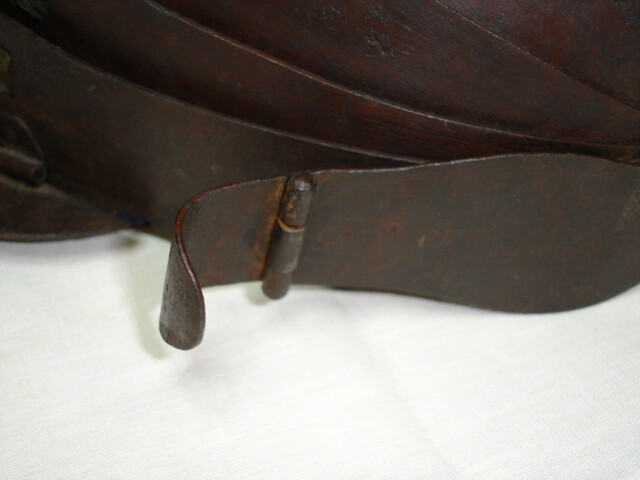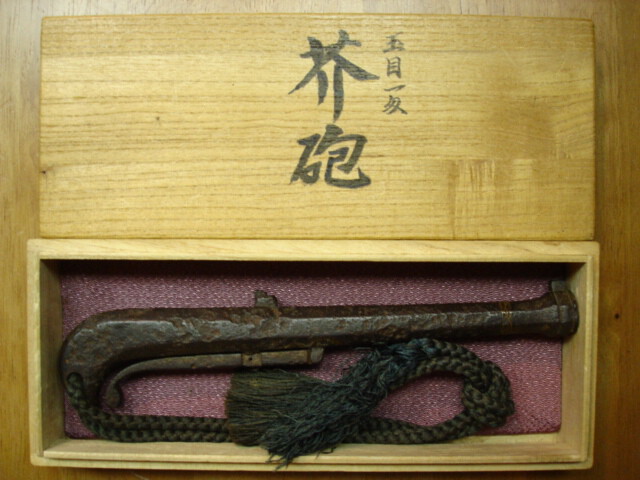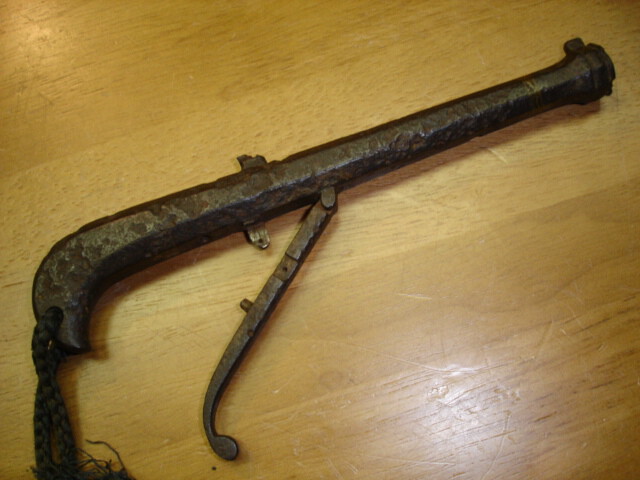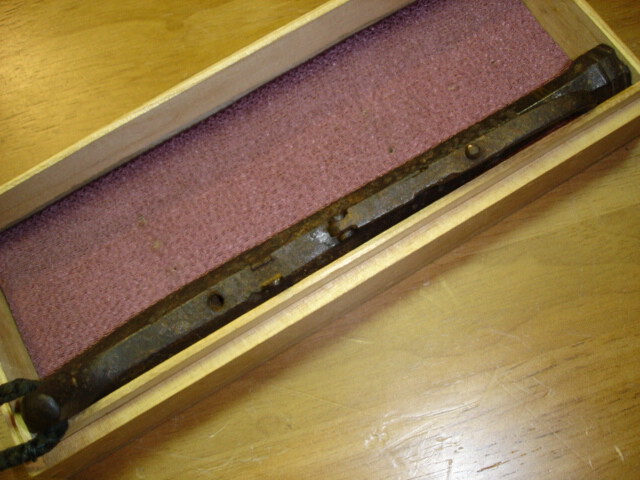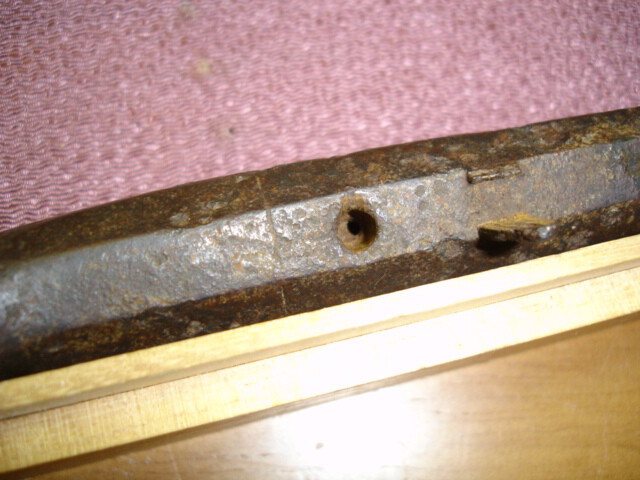-
Posts
14,092 -
Joined
-
Last visited
-
Days Won
261
Content Type
Profiles
Forums
Events
Store
Downloads
Gallery
Everything posted by Bugyotsuji
-
Personally I like the tsuba and the way the holes work for both the arrowheads and the tsuba itself. If you are wanting a translation of Koichi san's translation, it means
-
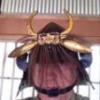
This Week's Edo Period Corner
Bugyotsuji replied to Bugyotsuji's topic in General Nihonto Related Discussion
Fantastic, Ian, thank you so much for that. Sets of holes in the iron plates for which no obvious purpose springs to mind had me puzzled; it could just be that such an ensemble as you describe was there originally. Or perhaps it has been adapted... -

This Week's Edo Period Corner
Bugyotsuji replied to Bugyotsuji's topic in General Nihonto Related Discussion
Sometimes you say the right thing, Jean!!! -

This Week's Edo Period Corner
Bugyotsuji replied to Bugyotsuji's topic in General Nihonto Related Discussion
-

This Week's Edo Period Corner
Bugyotsuji replied to Bugyotsuji's topic in General Nihonto Related Discussion
Ian, it would be very interesting to compare pictures. Your description is intriguing. Mine sounds similar in some respects. Is there a photo of the one in the Royal Armouries on the net anywhere? Can you take some shots of yourn? I will post mine. There was actually one more available with some sort of hanging padded iron ear flaps but it looked as though it would give me asthma so I left it. Maybe I can still get it from the dealer... but it will need some patient restoring. Smoke & mirrors... -

This Week's Edo Period Corner
Bugyotsuji replied to Bugyotsuji's topic in General Nihonto Related Discussion
No 1 above, the chochin half kabuto... hmmm. It is completely restored (thanks to the missus for making the E-boshi) and wearable now, but what is in dispute is the use of the Fuki-kaeshi. When I swivelled them down to below my ears and tied a shinobi-no-o to them, a very knowledgable Japanese collector friend laughed. No, no, no, he said, those are fukikaeshi and should not be swivelled down. Again I demonstrated what I thought to be a very reasonable use for these 'fukikaeshi' look-alikes, and he hesitated, sucked his teeth and then added that it might after all be possible, as to his knowledge there is no detailed illustrated record out there. I am now thinking that they served as fukikaeshi decoration in the folded-up position, but in real battle they could have served to hold the kabuto on more firmly and stop it flying off under violent head movement. -
This thread is quite educational. As to the tsuba itself, is it worth the cost of papering? Personally speaking, once burned twice shy. I tend to steer away from any tsuba that gives an iota of doubt. This saves me from spending money. Well, that's the theory anyway! :lol: What's wrong with big hands, Guido?
-

This Week's Edo Period Corner
Bugyotsuji replied to Bugyotsuji's topic in General Nihonto Related Discussion
Two other recent additions are: 1. a folding iron half helmet of the kind favoured by the Shinsen-Gumi in the Bakumatsu period, which I have been assured by my collector friends is, of its type, quite a find. I have had the wife run up an Eboshi and I am now in the process of sewing them together. It has little folding iron sun visors left and right over the eyes, and swivelling iron ear covers with hooks at the bottom to secure a jaw shinobi-no-o. The Eboshi will tie at the back like a Hachi-maki. 2. A shikomi tanto containing a yari no ho, from the end of the Edo Period. And we went to Hiroshima today to take the Shodan Shiken. They allowed me to move up a level. -

This Week's Edo Period Corner
Bugyotsuji replied to Bugyotsuji's topic in General Nihonto Related Discussion
See pic of said cross Mon on p8 of this thread about halfway down the page: viewtopic.php?f=9&t=2554&st=0&sk=t&sd=a&start=105 Well, Bugs, I came across a giant hint today concerning this cross Mon. (Talking to myself!) I bought a set of sleeves, which would have originally been worn under Kote, belonging to the Second Hachisuka Lord of Awa, who was given Awaji Island in 1615 by Tokugawa Ieyasu for his valiant fighting at the seiges of Osaka Castle. Hidden inside each sleeve was this very cross Mon, indicating, according to the writing on the box that they came in, that he was a Christian! Nowhere have I come across any other evidence so far that the Hachisuka used this Mon. I have been calling it 'Ken Juji', although I can find no record of such a name, (except for a Japanese fantasy game advertised on the internet about the Crusades and an upturned Western-style sword as a cross). This Hachizuka hidden cross, if that is what it is, is a lovely example to me of the the church militant, Japanese-style. A cross made out of crossed blades. (Almost a Shuriken, even.) But within a few short years it was to become a deadly secret. -

Menuki came with a strange wood tablet,Translation please?
Bugyotsuji replied to shan's topic in Translation Assistance
Hi Shan, looks like you got a temple/shrine good fortune talisman with your Menuki. Normally Japanese people would never open them up to see what's inside! The cover paper on the right says: O-Mamori (Protection) and the little wooden hanging plate says Narita-san on the front. See: http://www.naritasan.or.jp/ and watch the top picture change. Unfortunately I cannot read the writing on the back, but there is a chance they might be Sanskrit letters. Perhaps Koichi san can help? -
Oh, and the Habaki should pull backwards off the rusty Nakago. In the ideal state it should fit fairly tightly in place, and release with a little pressure. I wouldn't use too much force, but after the oil treatment, light tapping with a wooden block and rubber hammer might encourage it to make that vital first movement. Be careful, though, as copper can scratch easily, and some habaki are not as hard as they might look.
-

This Week's Edo Period Corner
Bugyotsuji replied to Bugyotsuji's topic in General Nihonto Related Discussion
Ian, are both hooks designed that way, or is one of them missing the extra prong? My feeble brain is suggesting some kind of barometer. Seasonal references? -
The gold colored/coloured sleeve on the blade is called a Habaki. It is part of the furnishings and blocks our view of the crossover area between the Nakago and the blade. This also slides off. Everything apart from the single flat blade-&-tang can be considered irrelevant to the discussion of your original question. If anything is old and possibly valuable, it will be the core of the beast. Unfortunately the photo quality doesn't quite cut the mustard. Do you have a friend with a digital camera who could co-operate with you? Here's hoping that someone else will step in and help out. I am sure that many people are waiting in the wings!
-
Hi Lori, Just had a quick look at your photos. Thanks for the quick response. If you can separate the blade/tang away from the Koshirae (sword furnishings, eg scabbard, hilt, etc. which are guaranteed to be 'young') and focus solely on getting good, clear close-up shots of the naked Nakago/Tang and naked blade, all over, that would be good. For example, both sides of the complete Tang, including the crossover area with the blade. Some overall shots of the blade, and then some detailed sections. Never touch the blade, and control the whole process by holding the Nakago. Use a soft towel if necessary.
-
Hi Lori, Welcome to the site. Quick answer is... it's anyone's guess until we see it, but it could be traditionally made and have no markings, yes. Slow answer is, take some pics overall and some close-ups of the Nakago (tang) and post them here for opinions. Read the site for hints on what kind of photographs to take. Also, general word of warning. I am sure you are aware that you should not try to clean either the blade or the tang in any way... (The blade maybe once you have learned how...)
-

This Week's Edo Period Corner
Bugyotsuji replied to Bugyotsuji's topic in General Nihonto Related Discussion
Oops... -
Rich, a friend showed me that very Tsuba the other day! On a J auction site last week there was a very rusted and pitted Tsuba from the Muromachi period described as having been damaged 'probably around the time it was made and probably in battle, judging from the age of the rust overall, including in the crater on the damaged edge'. The description went on to say that there was no actual proof, but such a scenario must be quite likely... I can hear the bloke muttering 'Roman da yo, ne!' (Romantic thought)
-
Managed to lose out a couple of times on the auctions, but finally... found a little iron Higo Tanto Tsuba with one hitsu ana opening. It has the Zogan remains of silver Sakura petals all round the Fuchi. The dealer sent it off today, so... tomorrow? Getting quite excited. Let's hope it fits without too much Seppa adjustment. No luck on finding a narrow Kozuka yet, although I have been looking and asking around. They seem to be as rare as*... and even if I found one I am not sure whether it would be within my budget for this project. The Tsuba has eaten up most of that. (*finish the saying! )
-

Sword for "left handed Samurai"
Bugyotsuji replied to stephan_hiller's topic in Auctions and Online Sales or Sellers
Samurai walked tending to the left of the roads/paths. Thus the scabbard would never click together with that of a stranger. Even today, knocking shoulders or bumping someone in public is considered the height of bad manners and can lead to violence if the apology is not accepted. For this reason, even if there were indeed left-handed Samurai, (one-armed for example I can understand) they would have been presented with a serious dilemma out of doors, necessitating some special design to get around the carrying problem. -

This Week's Edo Period Corner
Bugyotsuji replied to Bugyotsuji's topic in General Nihonto Related Discussion
Some of our members push tanto through their Do-jime-no-o, and I have toyed with the idea, but as you say, the thought of the saya banging on the Do or crunching under the tightening of the Do-shime is a bit daunting. Most of us have our swords hanging in the Tachi style. Now the lunch idea sounds very good, as long as I can see the collection before or after!!! I used to take my students for three week language courses at Leeds Metropolitan University, Beckett Park Campus, and often wandered around town, but why never to the Armouries? Nuts What I can remember is the mega huge Yorkshire puds with the roast beef roast spuds and gravy inside... and some very nice cold cider... -

This Week's Edo Period Corner
Bugyotsuji replied to Bugyotsuji's topic in General Nihonto Related Discussion
That's a nice site you have found there, Kenji san, based in Saitama I see. Thanks. Ian, this summer I will definitely visit the Royal Armouries on my way up to Scotland!!! (Bought your 1988 book on armour the other day, BTW, and looking forward to sitting down and reading right through it. One question I had. Did all samurai put their swords through their mawashi like that before putting on the 'Do', allowing the Tsuka to appear through the Kusazuri/Gessan odoshi, or only for example the Ashigaru illustrated in the series of pics?) PS Brian, any nice mail recently? -

This Week's Edo Period Corner
Bugyotsuji replied to Bugyotsuji's topic in General Nihonto Related Discussion
Going back into the recesses of my memory, but a Kyushu farmer once told me that they say Karashi for the wild poppies that grow in people's gardens. The character Karashi, Keshi, 芥 can also be read 'Akuta' which means annoying weeds, and is used to describe a plant that is very strictly prohibited and that you are doing your very best to eliminate. PS Nothing to do with the price of fish, but on the subject of plant similarities, :lol: people here in J describe the revolving chamber in a revolver as 'Renkon', which is a lotus root in cross-section. It is interesting that a popular food in Kyushu is 'Karashi Renkon' or lotus root slices stuffed with yellow mustard. -

This Week's Edo Period Corner
Bugyotsuji replied to Bugyotsuji's topic in General Nihonto Related Discussion
Nice article, Henk-Jan. Thanks. many years ago I wrote some papers on Joseph Heco (Hamada Hikozo) who is mentioned as Glover's assistant. Ian, as always, comes through with a good solid follow-up and I get to fill in more holes in my knowledge. Mustard/Poppy seeds, of course! (The words Karashi, mustard or Keshi, poppy are written with the same Kanji as on the box below) I was wondering what the connection with mustard/poppy was in the generic name I mentioned earlier, Kaihou, Mustard or Poppy gun. (Shades of Pepperbox! Especially the seven holed Nigiri-deppo.) The question about burning your hand struck me too. Perhaps they wore leather gloves! The long gun you describe Ian, is still found in Japan, but in very small numbers. I saw and played with one about four or five years ago. They are called Bo-so Raika Ju, and there were several variations. Yours sounds like one of the most evolved examples. Luckily I had my camera in the car yesterday and I ran out to get it. -

This Week's Edo Period Corner
Bugyotsuji replied to Bugyotsuji's topic in General Nihonto Related Discussion
Is everyone familiar with 'Nigiri-deppo' or 'Kaihou'? There was a transitional period between the traditional Hinawa-ju Tanegashima matchlock and the influx of 'modern' Western firearms when all kinds of experiments were being performed in Japan. Many 'Goku-mitsu-ju' were for personal protection or dastardly attack in the turbulent political switchover. The all-weather Nigiri-deppo was a pistol barrel with a parallel lever that you could squeeze to fire a little Raika ball like a Jintan into the chamber. The safety pin held the lever slightly open; pulling the pin meant that you could now squeeze and fire. Well, I have seen several examples of these, in pictures and in real life, but today I saw a genuine one for the first time. There was a boxed one discovered in the Matsudaira family in Takamatsu dated Tempo 11, and there is one in a museum in Tokyo, I have heard. This was another. Apparently they are so rare that 10 or so were made a few years ago to see how they work, and these are generally what people now have in their collections. One of the ways to discover which is genuine is the little hole for the primer ball: it should be 'stepped' or reduced by half inside. Many of the copies do not have this feature. :|



